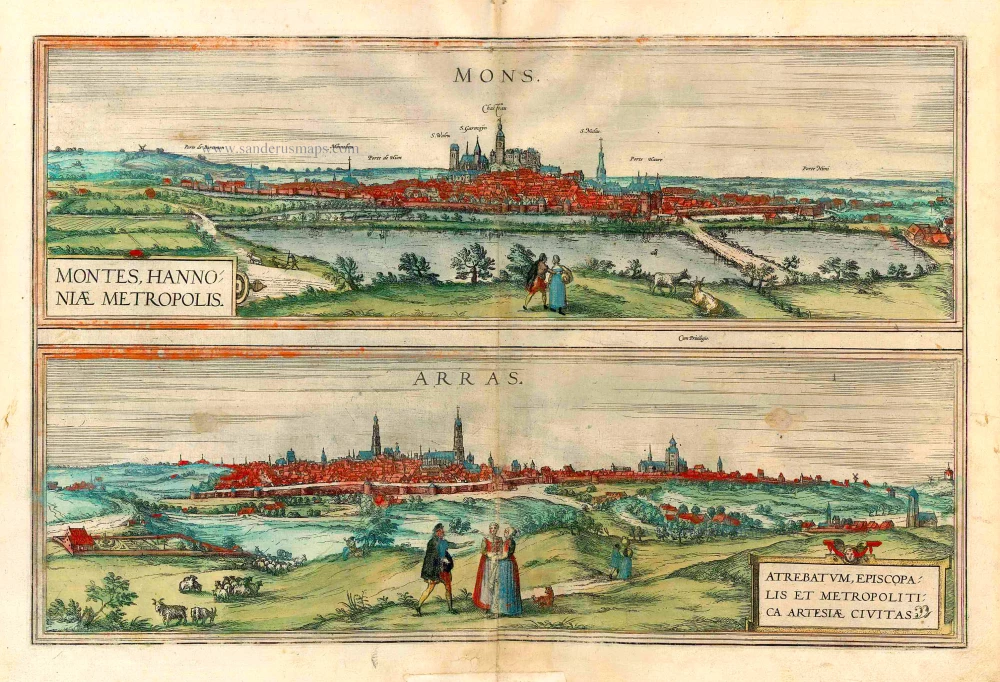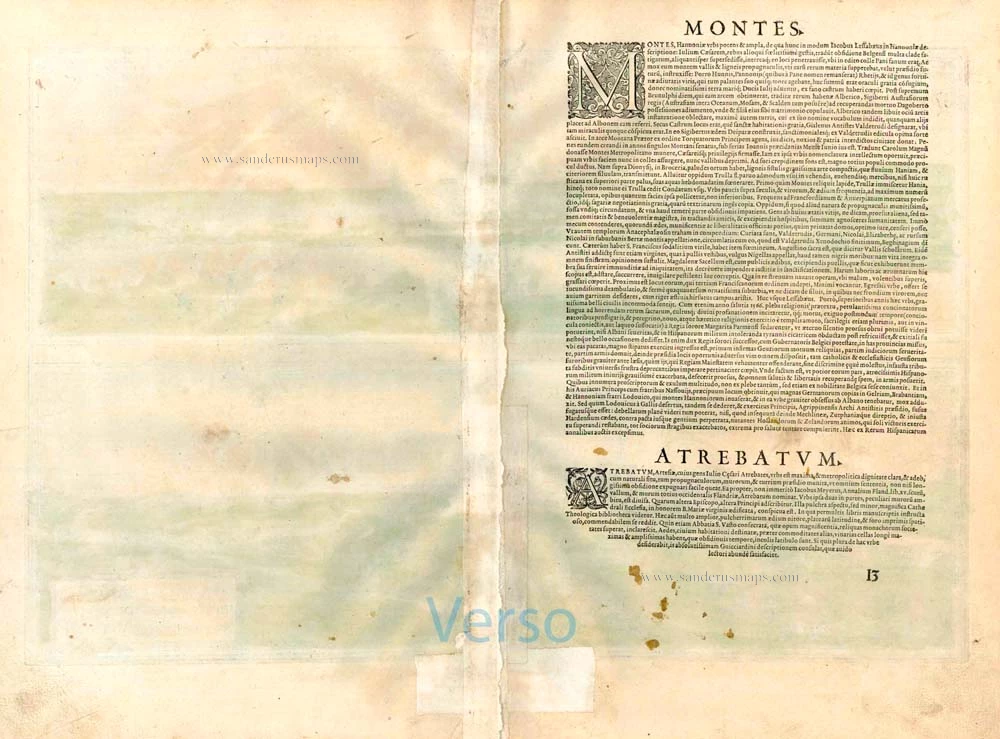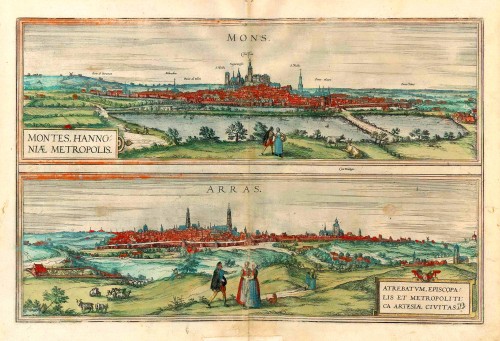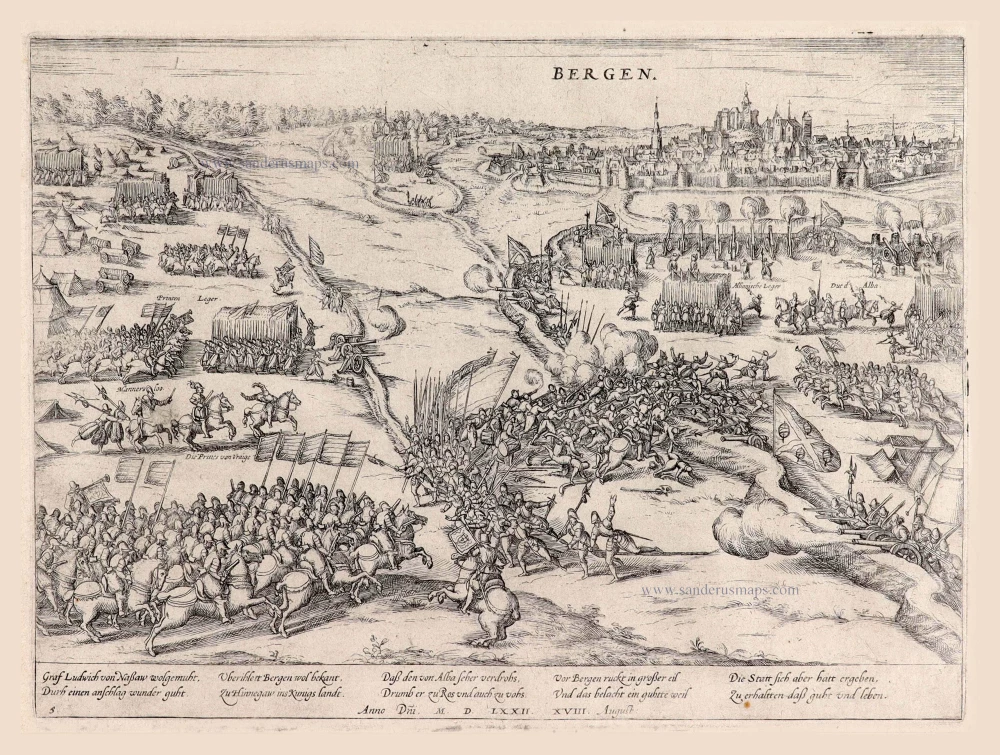MONS - ARRAS by Braun & Hogenberg 1582
MONS
CARTOUCHE: Mons, or Bergen, capital of the Haunault.
COMMENTARY BY BRAUN: "It is said that Emperor Charlemagne made Mons his capital and granted it imperial privileges. And he is supposed to have taken its name from its setting, which is namely hilly. Mons has grown substantially in several inhabitants and buildings in a short time. From here, a lively trade is conducted with Frankfurt and Antwerp; above all, it is a sort of cloth that they call Saye and is made in the many weaving workshops here. Thanks to its natural setting and fortifications, it is an extremely secure city, surrounded by a moat and hence not easy to besiege."
Mons lies on a slight hill beside the River Haine southwest of Brussels. Mons dates back to Roman times when Caesar erected a military camp on one of its hills during the Gallic Wars. The historical centre gradually spread outwards around a monastery founded in the 7th century by the city's patron saint, Waltrude of Mons. To protect Mons from attack, the count of Hainaut has a castle erected on the top of the hill. Emphasis falls upon the city's fields and meadows in reference to the productive local farming and livestock industries. Another sphere of economic activity was weaving; amongst the textiles manufactured in Mons was the famous green Saye, a woollen cloth derived from southern England.
ARRAS
CARTOUCHE: Arras, an episcopal city and capital of Artois.
COMMENTARY BY BRAUN: "This city is divided into two parts by its city walls, with one city assigned to the bishop, the other to the prince. Although the episcopal city is smaller, it is beautiful and distinguished by the main church dedicated to the Virgin Mary; it also has a magnificent library of written and printed theological books. The other part of the city is characterized by broad streets, very well-appointed houses and a second large market. In this part lies the abbey of Saint-Vaast, an extremely wealthy monastery."
The city of Arras (Dutch: Atrecht) in northern France is shown in side view and volume III from a birds-eye perspective. Since it lay for many centuries on the border between France and the Low Countries, it frequently changed hands. The episcopal city contains the church of Notre Dame. The grander prince's city includes the Benedictine abbey of Saint-Vaast (B), founded in AD 667 and dedicated to the city's patron saint. The monastery played an important role as a religious centre in the High Middle Ages, with an important scriptorium producing liturgical and theological manuscripts. Distributed via the Benedictine network, these manuscripts can today be found all over Europe. To its right lies the Gothic town hall (A) with its 75-m-high bell tower, begun in 1463 in the Gothic style, surrounded by impressive market squares that reflect the city's lively trading activities. Arras conducted business with Flanders and gained importance as one of the chief centres of the tapestry industry, its tapestries becoming known in English as "arras" and in Italian as "arazzi".
Mons - Montes Hannoniae Metropolis [on sheet with] Arras - Atrebatum, episcopalis et metropolitica Artesiae Civitas
Item Number: 25497 Authenticity Guarantee
Category: Antique maps > Europe > Belgium - Cities
Two bird's-eye views on one sheet: Mons and Arras, by Georg Braun and Frans Hogenberg.
Title: Mons - Montes Hannoniae Metropolis [on sheet with] Arras - Atrebatum, episcopalis et metropolitica Artesiae Civitas.
Date of the first edition: 1572.
Date of this map: 1582.
Copper engraving, printed on paper.
Size (not including margins): 320 x 485mm (12.6 x 19.09 inches).
Verso: Latin text.
Condition: Original coloured, excellent.
Condition Rating: A+.
From: Civitates Orbis Terrarum, Liber Primus. Köln, Gottfried von Kempen, 1582. (Van der Krogt 4, 41:1.1(1582))
MONS
CARTOUCHE: Mons, or Bergen, capital of the Haunault.
COMMENTARY BY BRAUN: "It is said that Emperor Charlemagne made Mons his capital and granted it imperial privileges. And he is supposed to have taken its name from its setting, which is namely hilly. Mons has grown substantially in several inhabitants and buildings in a short time. From here, a lively trade is conducted with Frankfurt and Antwerp; above all, it is a sort of cloth that they call Saye and is made in the many weaving workshops here. Thanks to its natural setting and fortifications, it is an extremely secure city, surrounded by a moat and hence not easy to besiege."
Mons lies on a slight hill beside the River Haine southwest of Brussels. Mons dates back to Roman times when Caesar erected a military camp on one of its hills during the Gallic Wars. The historical centre gradually spread outwards around a monastery founded in the 7th century by the city's patron saint, Waltrude of Mons. To protect Mons from attack, the count of Hainaut has a castle erected on the top of the hill. Emphasis falls upon the city's fields and meadows in reference to the productive local farming and livestock industries. Another sphere of economic activity was weaving; amongst the textiles manufactured in Mons was the famous green Saye, a woollen cloth derived from southern England.
ARRAS
CARTOUCHE: Arras, an episcopal city and capital of Artois.
COMMENTARY BY BRAUN: "This city is divided into two parts by its city walls, with one city assigned to the bishop, the other to the prince. Although the episcopal city is smaller, it is beautiful and distinguished by the main church dedicated to the Virgin Mary; it also has a magnificent library of written and printed theological books. The other part of the city is characterized by broad streets, very well-appointed houses and a second large market. In this part lies the abbey of Saint-Vaast, an extremely wealthy monastery."
The city of Arras (Dutch: Atrecht) in northern France is shown in side view and volume III from a birds-eye perspective. Since it lay for many centuries on the border between France and the Low Countries, it frequently changed hands. The episcopal city contains the church of Notre Dame. The grander prince's city includes the Benedictine abbey of Saint-Vaast (B), founded in AD 667 and dedicated to the city's patron saint. The monastery played an important role as a religious centre in the High Middle Ages, with an important scriptorium producing liturgical and theological manuscripts. Distributed via the Benedictine network, these manuscripts can today be found all over Europe. To its right lies the Gothic town hall (A) with its 75-m-high bell tower, begun in 1463 in the Gothic style, surrounded by impressive market squares that reflect the city's lively trading activities. Arras conducted business with Flanders and gained importance as one of the chief centres of the tapestry industry, its tapestries becoming known in English as "arras" and in Italian as "arazzi".





